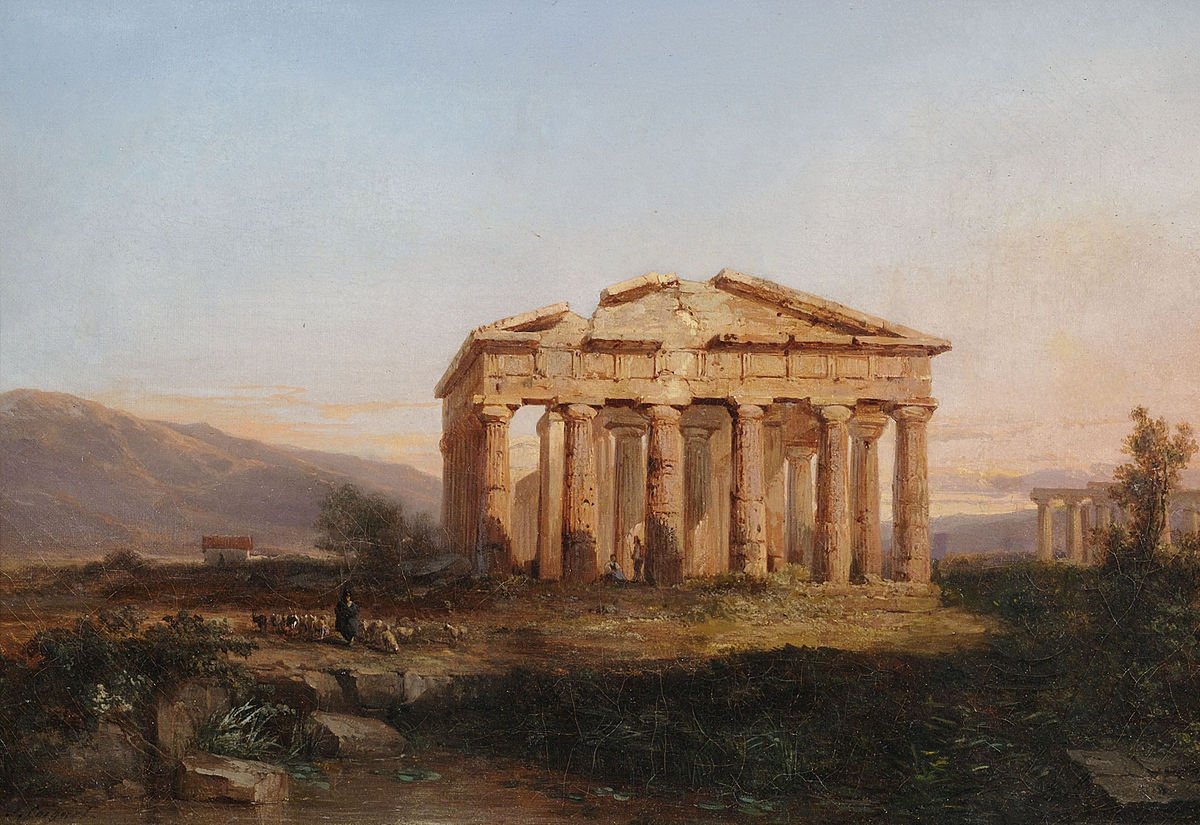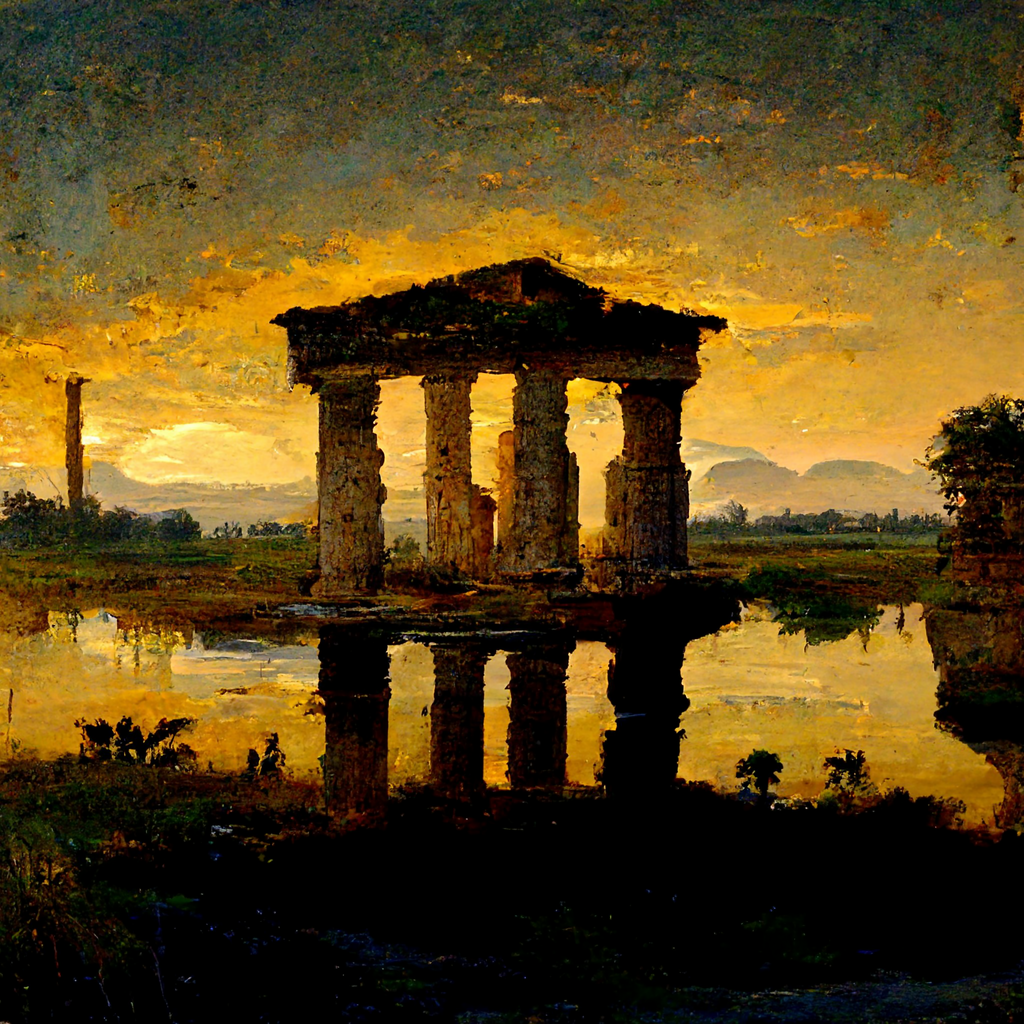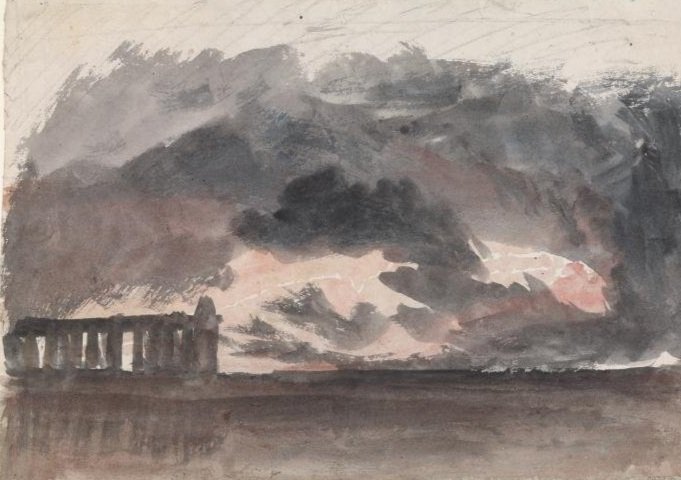POSEIDONIA /
POSEIDONIA /

POSEIDONIA is about the mythopoetic power of AI-generated images, timeless artworks in which the line between myth and future is blurred.
“You will not take and throw down the tower of this city,
Until on my precinct shall dash the wave
Of blue-eyed Amphitrite, roaring over the winedark sea.”
Pausanias, Description of Greece, 10.37.6
Aim
With POSEIDONIA I want to tell the story (and destiny?) of the Archeological Site of Paestum, Italy.
I will proceed by comparing scenes of the site from the Romantic period with AI-generated text-to-image synthetic artworks of the same subject.
Through the case study of Paestum, we’ll reflect on the broader topic of the spiritual, mythopoetic power of AI.
Can synthetic art capture what we can’t see? Can it grasp the essence of a place? Can it tell us its history? Can it predict its future? Can it make its myth come true?
Themes
Storytelling (Week #2)Story of Land (Week #4)Man & Nature (Week #5)Spirituality of TechAncient == Future ?THE MYTH
+
THE MYTH +
Paestum, as it is known today, was founded as Poseidonia, a Greek colony which flourished in the 5th century B.C.
Poseidonia was named after Poseidon, God of the Seas. Settlers likely dedicated the city to him as a sign of gratitude for a safe voyage across the Mediterranean.
However, it could have also be due to the central role of water in Poseidonia: founded in a swampy lowland, water drainage and storage, as well as fountains and wells were key to the city’s prosperity.
THE HISTORY
〰️
THE HISTORY 〰️
After the Greek control, Poseidonia then became a Lucanian territory (Paistom), a Roman city in 273 BC (Paestum, its current name) and eventually a bishopric of the Empire in 400 AD.
Paestum was abandoned around the year 1000, due to swampy malarial conditions and persistent barbaric incursions from the coast.
As settlers sought refuge on the neighboring mountains, Paestum, once a gem of the ancient world, started its decline, reclaimed by the waters.
“..and were encamped [...] on a Lucanian lake. This lake, they say, changes from time to time in the character of its water, becoming sweet, and then again bitter and undrinkable.”
THE FUTURE
>
THE FUTURE >
During the Renaissance, Paestum remained an Arcadian dream of unknown location, famous for the scent of its roses that blossom twice a year, mentioned in the works of Virgil and Horatius.
it was only centuries later that Poseidonia/Paestum was rediscovered, becoming one of the favorite stops of the artists who came from all over Europe for their Grand Tour.
In the XVIII and XIX century people could again the placid ruins kept hidden for so long.
“We crossed brooks and flooded places where we looked into the blood-red savage eyes of buffaloes [...].
The country grew more and more flat and desolate, the houses rarer, the cultivation sparser. In the distance appeared some huge quadrilateral masses, and when we finally reached them, we were at first uncertain whether we were driving through rocks or ruins.”
Poseidonia / Paestum, today, home to three of the best preserved Greek temples in the world and to rare examples of ancient Greek frescoes, is one of the 49 UNESCO World Heritage Sites in the world and 11 in Italy that is threatened by the sea-level rise.
The Mediterranean is an area particularly sensitive to climate change, and projections show a mean sea‐level rise of about +10 cm by 2050. “Poseidonia Water City”, an exhibit in 2020, discussed the threat posed by climate change and the relationship of the site with water throughout its history.
The future of Poseidonia/Paestum seems to be tragically yet ironically bounded to its mythical past: Is Poseidonia eventually going to be reclaimed by the quick-tempered, fickle, turbulent Poseidon?
Poseidonia appears to be a city
for the water
from the water
to the water.
〰️
〰️
In class we discussed a lot on the theme of Man & Nature. Sultan Islamovich explains the environmental catastrophe we are headed to with the concept of unity. During our journey throughout history, we lost the sense of unity with Nature. There is no longer a sustainable consensus between people and environment. We can’t practice kilo anymore, we are deaf to the voice of Nature.
As we move from a place of oneness to a place of fragmentarity, we are being wiped out. We are fought like a pathogen by a sick living organism trying to be healthy again. In the process, myth and future converge.
Through the words of Paul Carter: “when myths are renewed, a creative process referred to as mythopoesis, they are again a valuable means of representing a chaotic reality in a way that is not chaotic but dynamic and turbulent”.
concept:
concept:
Employ Midjourney AI to generate synthetic artworks of Poseidonia.Use captions that describe its predicted future, e.g. “Temples of Paestum reclaimed by the waters”.Present them side with man-made artworks of Paestum at the time of its discovery. All images have been deliberately left caption-less.
The result is an eerie gallery of artworks suspended in time in which the (future?) ruins of Poseidonia are rediscovered with the same excitement for the unknown of centuries ago: the myth of Paestum, like its roses, blooms once again. Generative AI is mythopoesis that represents the turbulent reality of climate change.Concept:
Which artworks are real?
Which artworks are synthetic?
Do they transmit the same feelings?
Which ones are showing the ruins’ past?
Which ones are a prediction of its future?
Does it make a difference?
“Atque equidem, extremo ni iam sub fine laborum vela traham et terris festinem advertere proram, forsitan [...] canerem biferique rosaria Paesti.”
——
”In fact, were I not, with my task well-nigh done, about to furl my sails and making haste to turn my prow to land, perchance I might sing of Paestum, whose rose bloom twice yearly.”
References
Poseidonia città d'acqua. Archeologia e cambiamenti climatici, G. Zuchtriegel, P. Carter, M. E. Oddo. Paestum: Pandemos, 2019-p. 367.
Poseidon’s Return, P. Carter, 2019
Pleasure of Ruins, R. Macaulay, Thames & Hudson Ltd; text Unabridged edition (28 Aug. 1984)
Paestum: A City, a Civilization, a Heritage. M. Mello. Journal of Aesthetic Education 19.1 (1985): 9-22.
https://museopaestum.cultura.gov.it/













